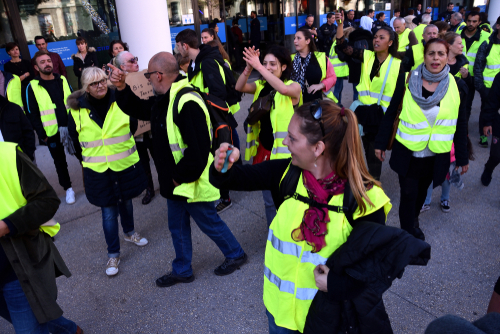France ‘yellow vest’ protesters defy government to gather
“Yellow vest” protesters have gathered in Paris and other cities for a fifth consecutive Saturday of demonstrations.
Protesters defied a government call to suspend the action following Tuesday’s attack on Strasbourg’s Christmas market where a gunman killed four people.
However, fewer people turned up – 66,000 altogether, officials said, compared to 125,000 last Saturday.
The movement, initially against a rise in fuel taxes, now addresses other issues, including education reforms.
Seven people have died in the “gilets jaunes” (yellow vest) protests so far, the latest in an accident resulting from a blockade by protesters on Friday.
How is this Saturday shaping up?
About 69,000 police have been mobilised across France to prevent a repeat of the violence of previous weeks.
In Paris, slightly more than 2,000 took to the streets on a cold and rainy day, compared to 10,000 last week.
Police stopped and questioned 168 people in the capital, detaining 115.
Scuffles broke out on the Champs-Elysées several times during the day, with police using tear gas and water cannon. However, as night fell, the iconic boulevard was reopened to traffic.
Seven people were injured.
Some museums were closed, but both the Louvre and the Eiffel Tower remained open.
In Bordeaux, more than 4,500 protesters took to the streets. Police had to use water cannon to disperse them. A similar number protested in Toulouse.
In Nantes, some 1,200 protesters saw rounds of tear gas fired at them.
Similar scenes occurred in Avignon and Besançon.
In Calais, a group of “yellow vests” blocked the access road to the port.
Thinning support?
Analysis by Hugh Schofield, BBC News, Paris
A few hundred desultory figures in day-glo vests wander up and down the Champs Elysées. Occasionally there are whoops and jeers, followed by a bang and a bit of gas. A group of protesters has got too close to a police cordon, and a show of force pushes them back. The mini-panic lasts about 15 seconds.
That is about the extent of the fifth yellow-vest demonstration, which confirms the downward trend of last Saturday. Maybe the troublemakers will enter the game like they did last week – but it can’t be on the same scale, because today there simply aren’t enough bona fide protesters around to give them cover.
The “gilets jaunes” who have turned out seem to be the hardline left-wing element. There is a lot of talk about the “RIC” – Citizens’ Initiative Referendums. This is a demand of the far-left leader Jean-Luc Mélenchon – and a long way from the yellow vests’ original call, which was for a simple cut in fuel tax (long since conceded).
The movement – or at least the Saturday protest movement – is shrinking and hardening.
But has the government not made a U-turn?
The impact of the demonstrations has been keenly felt in France. The government has been forced to bow to pressure and adjust its economic course.
President Emmanuel Macron responded to the nationwide street protests by scrapping an unpopular fuel tax rise, and promising an extra €100 (£90; $114) a month for minimum wage earners and tax cuts for pensioners.
However, it is far from clear that he has done enough to defuse public anger.
What is the yellow-vest movement?
The protesters adopted the name after a social-media campaign urging people to take to the streets wearing the high-visibility yellow jackets that must be carried in every vehicle in France.
They were initially protesting against a rise in duties on diesel, which is widely used by French motorists and has long been less heavily taxed than other types of fuel.
Mr Macron had said higher taxes on fossil fuels were needed to fund renewable energy investments.
But protests have also erupted over other issues, including calls for higher wages, lower taxes, better pensions and easier university entry requirements.
The movement’s core aim, to highlight the economic frustration and political distrust of poorer working families, has widespread support.

